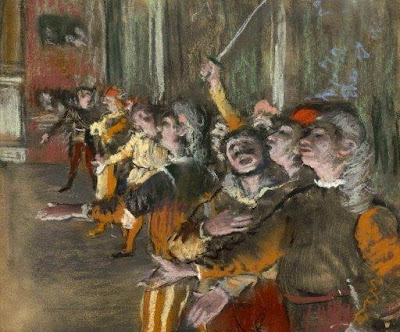
Missing painting is the real deal
It was the old switcheroo. All that remains at the Barrie
Art Club is a copy of AJ Casson's 50-year-old gift to the club.
Barrie Art Club members have a sneaking suspicion that sometime during the last couple of months someone replaced their original AJ Casson painting with the copy they kept on display.
When members wanted to show visiting Orillia-area artist Dave Beckett the original last week, it was nowhere to be found.
On Thursday, Gary Owen of Gary Owen Custom Framing, examined the one that they do possess.
"It's the print," he confirmed. "They mixed up some wires."
AJ Casson was a later member of the famed Canadian artists, The Group of Seven.
In 1959 he conducted a workshop for the Barrie Art Club, creating the 9x12-inch 'House and Hills' oil sketch. When he was done, he signed it and donated it to the club.
It has since remained in the Barrie Art Club's permanent collection, with about two dozen other paintings.
"There are a lot of possibilities," said art club vice-president Carol Mueller. "We had the original in safe keeping and the copy was on display."
Or so they thought.
Casson was a prolific painter and he lived a long time. He died in 1992 at the age of 94. His catalogue is filled with paintings of landscapes and towns throughout Central Ontario.
"I think he was pretty active, so there's a lot of them around," said Owen, who has framed some of Casson's originals over the years.
Barrie police expect to conduct an exhaustive investigation.
"We have a fairly heavy task of: A -Determining when this painting was stolen; and B - Who stole it," said Barrie Police Sgt. Robert Allan.
What police believe may have happened is that someone took the original out of storage and replaced it with the copy.
Police expect to talk with members of the club to help find some of those answers. But they're also hoping to reach out into the local art community for help.
The painting was assessed at $25,000 in 2002. Allan said its value has been estimated at anything between $25,000 and $60,000.
"It's going to be a long, difficult road unless we get co-operation from the public and the art community," said Allan.
Interestingly, Casson often leant his expertise to investigators with the Ontario Provincial Police. An enterprising counterfeiter in the 1960s realized there was good money to be made on Group of Seven paintings, even if they weren't really done by the artists.
An OPP inspector by the name of Erskins teamed up with Casson to look at paintings that were attributed to the Group of Seven.
"Erskins and Casson would show up to authenticate a painting and there would be a dinner party going on, in their honour," said Chris Jackson, a freelance Orillia curator who has worked with Kleinburg's McMichael Canadian Art Collection, the Art Gallery of Hamilton and the Glenbow art gallery in Calgary. "Casson said he never found a fake Casson."
Jackson curated an exhibit of AJ Casson three years ago. When it arrived at Barrie's Maclaren Art Centre, he met with the Barrie Art Club and Casson's 'House and Hills' went on display for the show's duration in Barrie.
The Group of Seven subconsciously divided up the country among themselves. And other than their focus on Algonquin Park and Algoma, Casson thought Ontario was under represented.
"He basically carved out Ontario as his bailiwick for all his career," said Jackson.
He considered himself a recorder of small-town Ontario. And along his travels, he would put on demonstrations for art clubs, like the one he did in Barrie in 1959. And, often, he would leave a memento of his visit behind.
While the painting would be valuable to the club, it's not likely Casson would have considered selling it, because it was more of an oil sketch completed for demonstration purposes than a complete painting, said Jackson.
But since the members have all passed on, all their work is considered valuable.
The painting also provides a direct connection between Barrie, the art club and the famed painter.
The value of the art of the Group of Seven has steadily increased in the past decade alone, Jackson said.
Art Hostage Comments:
-
Sometimes it's not good to be right, says Art Hostage smiling like a Cheshire Cat !!!!!









